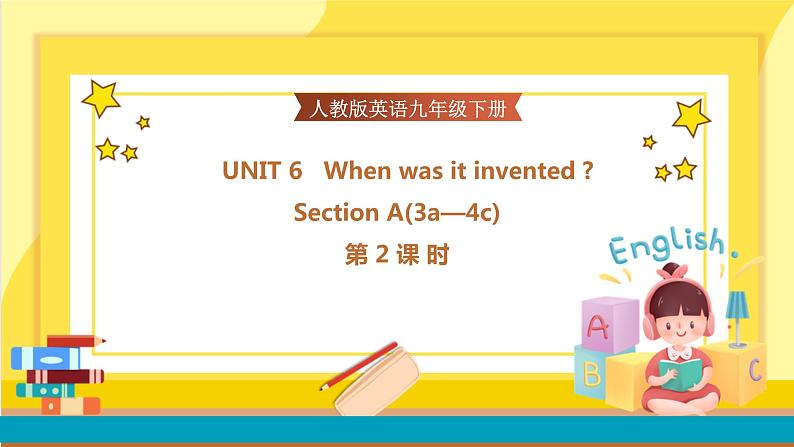











初中英语人教新目标 (Go for it) 版九年级全册Section A优质课件ppt
展开UNIT 6 When was it invented?
Section A(3a—4c) 第2课时
设计说明 本课时学习茶发明的相关阅读。教学时通过一段有关茶艺的录像导入新课:茶是谁发明的,什么时候发明的及怎样发明的;然后通过速读、细读的方法,引导学生逐步理解课文;单元语法教学先让学生通过课文中的被动语态的句子感知体验,然后归纳总结,最后通过练习加以巩固。 教学目标 通过本课时的学习,让学生达成以下目标: 1. 知识目标 (1)单词:accidental, ruler, boil, remain, smell, saint, national, trade, popularity, doubt, fridge, low, somebody, translate, lock, ring, earthquake, sudden, bell, biscuit, cookie, musical, instrument (2)短语:by accident, take place, without doubt, all of a sudden (3)句子:①Many people believe that tea was first drunk about 5,000 years ago. ②It is said that a Chinese ruler called Shen Nong was the first to discover tea as a drink. ③In England, tea didn’t appear until around 1660... 2. 能力目标: (1)了解茶的发明及传播; (2)掌握一般过去时的被动语态的用法。 3. 情感目标: 了解中国传统文化,培养学生的民族自豪感。 重点难点 1.重点:(1)本课时的单词、短语和句型; (2)一般过去时的被动语态。 2.难点:(1)运用被动语态谈论发明; (2)一般过去时的主动语态和被动语态之间的转化。 教学准备 PPT课件 教学过程 Step 1 Lead-in Play a short video for the students to learn about Chinese tea. Step 2 Reading Fast reading 1. Skim the passage and then answer the questions. (1)When was tea invented? (2)Who invented tea? (3)How was it invented? Check the answers one by one. Answers: (1) About 5,000 years ago. (2) It was invented by a Chinese ruler called Shen Nong. (3) It was invented by accident. 2. Read the passage quickly and match each paragraph with its main idea. Paragraph 1 Lu Yu and his book Cha Jing Paragraph 2 How tea spread to other countries Paragraph 3 How tea was invented by accident Check the answers. Answers: Paragraph 1 Lu Yu and his book Cha Jing Paragraph 2 How tea spread to other countries Paragraph 3 How tea was invented by accident Careful reading 1. Read and choose the right answers. (1) What is the passage about? A. What tea is. B. Where tea comes from. C. How tea was invented. D. How a cup of tea is made. (2) Tea wasn’t invented by accident, was it? A. Yes, it wasn’t. B. Yes, it did. C. No, it wasn’t. D. Yes, it was. (3) When did tea appear in England? A. Around 1660. B. Around 1670. C. Around 1760. D. Around 1770. (4) Where was tea invented? A. In China. B. In Singapore. C. In England. D. We don’t know. Check the answers one by one. Answers: (1)—(4) C D A A 2. Read Para. 1 and complete the chart.
Check the answers. Answers: Shen Nong, tea, China, boiling, fell into, remained produced, tasted, drinks 3. Read Para. 2 and complete the passage. A few _______ years later, Lu Yu,“the saint of tea”,_______ Shen Nong in his book Cha Jing. The book describes how tea plants _______ and used to make tea. And it also discusses where the finest tea leaves ______ and what kinds of water _______. Answers: thousand, mentioned, were planted, were produced, were used 4. Read Para. 3 and complete the sentences. (1) Tea was brought to Korea and Japan during _________________________. (2) In England, tea didn’t appear until around _____________. (3) The tea trade from China to Western countries took place in the ___________. Check the answers. Answers: (1)the 6th and 7th centuries (2)1660 (3) 19th century Post reading Task 1 Read the passage again and answer the questions. (1)When was tea first drunk? (2) How was tea invented? (3) Who is called “the saint of tea”? (4)What is Cha Jing about? (5) When was tea brought to other countries? Check the answers one by one. Answers: (1)It was first drunk about 5,000 years ago. (2) Some leaves from a tea plant fell into the boiling water when Shen Nong was boiling drinking water over an open fire. It produced a nice smell and tasted delicious. (3)Lu Yu is called “the saint of tea”. (4)It describes how tea plants were grown and used to make tea. (5) It was brought to Korea and Japan during the 6th and 7th centuries and to England around 1660. Task 2 Work on 3c. Complete the sentences with the correct forms of the verbs in the box.
1. One of the world’s favorite drinks was _________ by accident. 2. Tea was first ________ by Shen Nong about 5,000 years ago. 3. A nice smell was _________ when the tea leaves dropped into the hot water. 4. Tea was ________ to Korea and Japan during the 6th and 7th centuries. 5. Tea is now _______ between many different countries. Check the answers one by one. The answers are: 1. invented 2. drunk 3. produced 4. brought 5. traded Step 3 Grammar Focus Find the sentences with passive voice in the simple past tense. 一般过去时的被动语态的构成:was / were+及物动词的过去分词。 一般过去时的被动语态的句型: 肯定句: 主语 + was/were +及物动词的过去分词(+by…). The news was published by the government. 否定句: 主语 + was/were + not +及物动词的过去分词(+by…). The news wasn’t published by the government. 一般疑问句: Was/Were + 主语 +及物动词的过去分词(+by…)? Was the news published by the government? 特殊疑问句: 疑问词 + was/were + 主语 +及物动词的过去分词(+by...)? When was the news published by the government? 【拓展】 (1) “不及物动词+介词/副词”构成的短语动词,变为被动句时,要把它们作为整体看待,介词或副词不可与其动词拆开或漏掉。如: Our homework was handed in yesterday afternoon. 昨天下午我们的作业被交上了。 The house was fixed up by my father. 房子被我父亲修缮了。 (2)含有双宾语的主动句变被动句时,可将主动句中的直接宾语或间接宾语变为被动句中的主语。如果把主动句中的直接宾语(指物)变为被动句中的主语,则需在间接宾语(指人)前加适当的介词to或for。 如: 主动结构: Danny gave me a ticket just now. 刚才丹尼给了我一张票。 被动结构: A ticket was given to me by Danny just now. (直接宾语作主语) I was given a ticket by Danny just now. (间接宾语作主语) (3)有些动词常用其主动形式表示被动意义,如sell, wash, write等和表示感觉、知觉的系动词feel, sound, taste, smell等。 如: This kind of dress sells well. 这种裙子卖得好。 The fish tastes very delicious. 鱼肉尝起来很美味。 (4)在主动句中, 使役动词(如make等)和感官动词(如see, watch, notice, hear等)后面常接不带to的动词不定式作宾语补足语; 但在被动句中,这些词后面的动词不定式都需要带to。如: The boss made us work for ten hours today. 今天老板让我们工作了10个小时。 →We were made to work for ten hours today by the boss. Mom heard Ben sing in the next room. 妈妈听到本在隔壁房间唱歌了。 →Ben was heard to sing in the next room by Mom. 【助记】感官动词 一感二听三让四看 主动句中to 离开,被动句中to回来 Step 4 Practice Work on 4a. Rewrite the sentences using the passive voice. 1. They sold the fridge at a low price. _______________________________ 2. Somebody stole my camera from my hotel room. _________________________________ 3. Where did you take these photos? __________________________________ 4. Our parents advised us not to go out alone. __________________________________ 5. Different writers translated the book into different languages. __________________________________ Check the answers one by one. Answers: 1. The fridge was sold at a low price. 2. My camera was stolen from my hotel room. 3. Where were these photos taken? 4. We were advised by our parents not to go out alone. 5. The book was translated into different languages by different writers. Work on 4b. Complete the sentences with the correct forms of the verbs in the box.
1. You ____________ to the party last night, weren’t you? Why didn’t you go? 2. The earthquake happened all of a sudden, but luckily the villagers ________ to a safe place. 3. The door __________ when we arrived, so we ________ the bell. 4. The students _________ not to eat or drink in class, but Ruby ________ the rule when she started eating a biscuit in science class. 5. The cookies __________ by the hungry kids in less than 20 minutes, and they really ________ them. Check the answers one by one. Answers: 1. were invited 2. were brought 3. was locked; rang 4. were told; broke 5. were eaten; liked Work on 4c. Decide whether active or passive forms should be used in these sentences. Write the correct forms in the blanks. The telephone ________ (invent) by Alexander Graham Bell. He ________ (born) in 1847. Mr. Bell ________ (work) on the invention of the telephone with Thomas Watson. In 1875, Mr. Bell ________ (learn) how to send musical notes through an instrument similar to a telephone. Finally, the telephone ________ (invent) in 1876. The first sentence that ________ (say) on the telephone by Mr. Bell was “Mr. Watson, come here; I want to see you. ” Today the telephone ________ (use) around the world. Check the answers one by one. Answers: was invented; was born; worked; learned; was invented; was said; is used Step 5 Language points 1. It is said that a Chinese ruler called Shen Nong was the first to discover tea as a drink. 据说一位叫作神农的中国统治者最早发现了茶可以饮用。 the first to do sth. 第一个做……的人 It is said that…据说……(that后接完整的句子) 【拓展】 It is believed that... 人们认为……,人们相信…… It is known that... 众所周知…… It is reported that... 据报道…… 2. Some leaves from a tea plant fell into the water and remained there for some time. 一些叶子从茶树上落入水里并在里面停留了一段时间。 remain (1) v.某人或某事物仍保持某种状态 He remained silent. 他保持沉默。 It remains a secret. 这仍然是个秘密。 (2) v.剩下;剩余;遗留 After the flood, nothing remained of the village. 洪水过后,村庄荡然无存。 3. The tea trade from China to Western countries took place in the 19th century. 从中国到西方国家的茶叶贸易始于19世纪。 take place发生;出现 Great changes have taken place in our hometown during the past ten years. 在过去的十年里,我们家乡发生了巨大的变化。 The meeting will take place soon. 会议即将举行。 Step 6 Summary by accident 偶然;意外地 It is said/believed that... 据说……/相信…… the first to do sth. 第一个做某事的人 fall into 落入 be brought to sp. 被带到某地 take place 发生;出现 help to do sth. 帮助做某事 help sb. (to) do sth. 帮助某人做某事 =help sb. with sth. even though 即使 without doubt 毫无疑问;的确 Step 7 Homework 1. Review the passage and the grammar we have learnt today. 2. Preview 1a—1e on page 45. 板书设计
| |||||||||||
英语Section A精品课件ppt: 这是一份英语Section A精品课件ppt,文件包含UNIT8SectionA3a-4c第2课时pptx、UNIT8SectionA3a4c第2课时docx、UNIT8SectionA3a4c第2课时练习docx等3份课件配套教学资源,其中PPT共37页, 欢迎下载使用。
初中人教新目标 (Go for it) 版Section A完整版课件ppt: 这是一份初中人教新目标 (Go for it) 版Section A完整版课件ppt,文件包含UNIT7SectionA3a-4c第2课时pptx、UNIT7SectionA3a4c第2课时docx、UNIT7SectionA3a4c第2课时练习docx等3份课件配套教学资源,其中PPT共30页, 欢迎下载使用。
初中英语人教新目标 (Go for it) 版九年级全册Unit 4 I used to be afraid of the dark.Section A试讲课课件ppt: 这是一份初中英语人教新目标 (Go for it) 版九年级全册Unit 4 I used to be afraid of the dark.Section A试讲课课件ppt,文件包含UNIT4SectionA3a-4c第2课时pptx、UNIT4SectionA3a4c第2课时docx、UNIT4SectionA3a4c第2课时练习docx等3份课件配套教学资源,其中PPT共36页, 欢迎下载使用。














